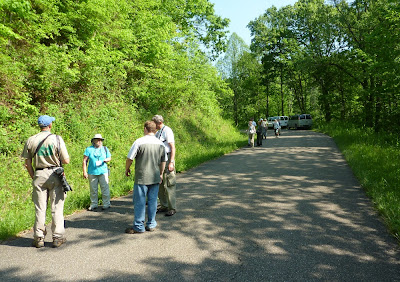The gathering point for this nature-lover's event is the lodge at Shawnee. Events begin with dinner and speakers Friday night.
I set the alarm for early on Saturday morning in case the weather, which had been overnight rain, allowed Bob Scott Placier to attempt a bird-banding. Dubious because of the wet conditions, we nevertheless went to the patio and found Bob ready to go. Ten or so of us followed Bob to his nets, where he found one ovenbird. At the patio our captive was measured, weighed, banded, and then photographed by his many admirers before release.
It was still damp when the day's expeditions were ready to depart, but the lighter sky promised imminent relief.
The trip Joan and I had chosen was to the Spring Glen Private Reserve, and led by Paul Knoop and Steve McKee. One creature adventure began right away, where the water-filled ruts of an old farm road had become a vernal pool: there were double strands of frog eggs, and then this fellow was discovered.
Shortly thereafter we left the road for the woods. I was not yet in a picture-taker's frame of mind, and skipped many floral photo opportunities, but when Paul captured an eastern fence lizard, the camera came out quickly.
This individual was a male, and we could see the iridescent blue patches on his throat.
We returned to the van for lunch, and then began an afternoon loop. Our keen-eyed guides pointed out a six-spotted tiger beetle briefly resting on a log.
Just ten minutes later we found someone truly special ... a yearling eastern box turtle!
The eastern box turtle population is suffering from collection for the pet trade, especially for export from the United States, and from habitat fragmentation. They are listed in the CITES Appendix II category, meaning that they aren't threatened yet, but will be if current trends continue.
Twenty minutes later we encountered another young box turtle; our guides estimated this one as three years old.
It was turning into a box turtle day. Next we found a full-size one. Notice that the ridges on his top plates have been smoothed away ... he's an older gent.
We didn't know how old until we picked him up to examine the ventral plate, which is one way to determine gender. (There's a depression in males.)
Wait a minute, what's that carving?
It looks like "FT 41." Someone carved his or her initials on this turtle in 1941, and he had to be large enough for carving into then, meaning that our friend is about 80 years old. This longevity is plausible; they are known to live to 100 years.
This specimen is a male -- the tympanum, or "ear drum", is larger than the eye, and it has a yellow throat.
About half an hour later, we came across yet another box turtle. The growth ridges on the edges of each plate of the shell are still prominent, so this one is much younger than the octogenarian. By the end we would see a total of five box turtles on this walk.
As the afternoon wore on we entered an area with weathered limestone boulders. The alkaline environment of the limestone provides a habitat for many ferns, columbine, and solomon's seal. Here Paul stands next to one such rock.
My sole floral photo for this first day of the Quest is this solomon's seal growing from that rock.
Sunday, a half-day, was much more floral. We boarded vans and our guides took us on a tour of Saturday's best finds. (Not all vans went to the same location at the same time, of course.) My first picture of the day was the lucky chance of seeing a predatory fly on the side of the trail enjoying a late breakfast.
I learned about twice-cut, or twice-pinnate, ferns on this walk, but didn't take any photos. On our second and third stops, I made up for it. First, we pulled over to admire fire-pinks.
They were all over the sunny side of this road.
Some folks will go to any length (or height) to get a good look or photo.
The next stop filled the remainder of the morning. One of our first finds was a "fairy wand" or "devil's bite," and there would be more of them.
Mountain laurel was blooming in profusion.
Everyone was oohing over the pink lady slippers to be found here.
In spots there were clusters of them.
There were even some yellows!
Then it was time for lunch back at the lodge, and the drive home. I had begun the weekend with the expectation that I wouldn't have enough interesting photos for a blog entry, but I was wrong!


























No comments:
Post a Comment
Comments may not appear immediately as they are moderated by the author to eliminate spam. Please, no commercial links!